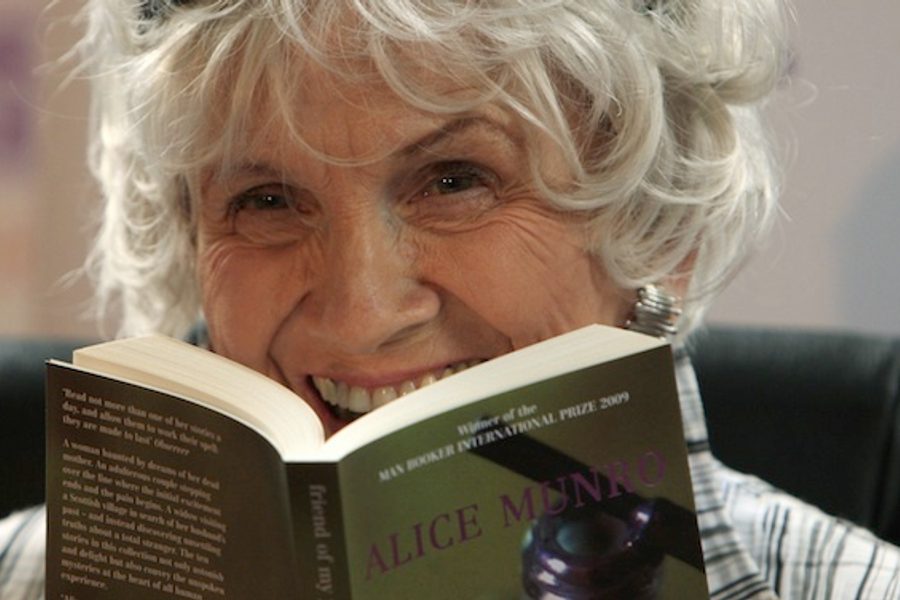Serious Heterosexual Guys, Make Way for Munro
Alice Munro’s Nobel victory signifies a changing view of literature.
Jude Ellison Sady Doyle

On September 25, Random House of Canada blog Hazlitt published the musings of minor Canadian novelist and University of Toronto Professor David Gilmour, who had decided to advance his teaching career by giving what must be the most ill-advised professorial interview of all time.
“I just haven’t encountered any Canadian writers yet that I love enough to teach,” he told Emily Keeler. “I’m not interested in teaching books by women. Virginia Woolf is the only writer that interests me as a woman writer … What I’m good at is guys. Very serious heterosexual guys. F. Scott Fitzgerald, Chekhov, Tolstoy. Real guy-guys. Henry Miller. Philip Roth.”
Lest readers think the exclusion of women and Canadians from his classes is a matter of sheer personal preference, Gilmour added, later in the interview, that he teaches “only the best.”
Fifteen days later, Alice Munro, a Canadian woman, won the Nobel Prize in Literature.
The news of Munro’s win was met with widespread jubilation — it was impossible to check Twitter without catching wind of it — and it’s not hard to see why. The 81-year-old writer had been quietly crafting exquisite, easy-to-love short stories for fifty years, all the while racking up a reputation (according to the New Yorker, among other sources) as the “Chekhov of the English language.”
Plenty of slaps were aimed at Gilmour, during the public celebration of Munro’s win, and rightly so. (Although it’s worth pointing out that Gilmour is apparently familiar with her work; when he did another, equally disastrous interview with the National Post in his own defense, it turned out that Munro, Woolf and Margaret Atwood were the only female writers he could name.)
Some other writers decried the Gilmour jokes as drawing undue attention away from Munro’s win. But in fact, they symbolize a key part of the process: Both Gilmour’s public disgrace and Munro’s public coronation signify a re-definition of what readers and critics are willing to consider “serious” literature.
Munro is not a terribly polarizing or radical writer. The New York Times called her win “a temporary relief from recent years when the Swedish Academy chose winners who were obscure, difficult to comprehend or overtly political.” She’s described herself as “left-wing” at times, but shies away from being described as a feminist: “In the beginning I used to say, well, of course I’m a feminist. But if it means that I follow a kind of feminist theory, or know anything about it, then I’m not,” she told the Prague Review.
Her writing, however — and her approach to it — has always been, if not feminist, distinctively conventionally feminine. Munro, now officially championed by the Nobel committee as the great master of the short story, has never written a novel; she’s spoken about being disappointed that she couldn’t, and feeling that her work was destined to be minor because she couldn’t write a big, sprawling Serious Book. It’s not hard to suspect that, at least early on, the size of her work had something to do with her writing process, which was very much defined by the rules of traditional womanhood: She married young, had two daughters quickly, and wrote only while they were away at school or taking naps. Even so, she’s beaten herself up publicly for being too committed to the work: “Some part of me was absent for those children, and children detect things like that. Not that I neglected them, but I wasn’t wholly absorbed. When my oldest daughter was about two, she’d come to where I was sitting at the typewriter, and I would bat her away with one hand and type with the other,” she said in the same Prague Review interview.
Try to imagine a male author being so guilty about that kind of creative focus that he mentioned it in an interview several decades after the fact. I’m wracking my brain for a plausible example, but the fact is, it just doesn’t happen. Novelists — and novels — have traditionally been rewarded for taking up space, taking risks, dedicating every part of their lives to their creative talent and jettisoning that which doesn’t work. A novel is a big statement, a fairly entitled Alice Munro one: It asks you to give up a few days or weeks of your life just to see what some guy’s been daydreaming about. As such, it’s considered both a more masculine and a more serious form than the short story.
And her work also reflects her life’s constraints. Her short stories focus on concerns long thought to be sentimental: The inner lives of women, marriage and its discontents, domesticity. Of course, men have always had the prerogative to write about marriages and wives. But to write about wives, when you are yourself a wife, is a trickier proposition: It casts you as limited, petty, trivial. Fellow Canadian author Margaret Atwood has noted that, early in her career, Munro was downed for being a “housewife” and “boring.”
If you’d like a more verbose and recent version of the same complaint, you can read Christian Lorentzen’s 2012 take on Munro in the London Review of Books. He slams her for being provincial, prudish, domestic; he’s quite miffed that one of her female characters takes insufficient pleasure in a threesome.
Reading ten of her collections in a row has induced in me not a glow of admiration but a state of mental torpor that spread into the rest of my life. I became sad, like her characters, and like them I got sadder. I grew attuned to the ways life is shabby or grubby, words that come up all the time in her stories, as well as to people’s residential and familial histories, details she never leaves out. How many rooms are in the house, and what sort of furniture and who used to own it and what is everybody wearing? To ask these questions is to live your life like a work of realism.
More accurately, to ask these questions, and to take some necessary interest in their answers, is to live your life as women have lived it for most of recorded history. To worry about the house — how big it is, how well it’s provided for, how well everyone gets along within it — is inevitable for a group of people who have historically been constrained to the home, with relationships as their only real form of capital.
But this has been Munro’s path: Creating small (read: short) pieces about small (read: female) concerns. The fact that the results are frequently breathtaking has never quite been enough for those who prefer their literature long, thick and hard.
Which brings us back to David Gilmour. The “serious heterosexual guys” he champions have been the face of serious writing for as long as anyone can remember: Either a bunch of long-dead Old-Worlders with broad social concerns (Chekhov, Tolstoy), or naughty boys who mistreat their wives and detail their sexual escapades, substance use and generally provocative lifestyles for the public’s entertainment (Fitzgerald, Miller, Roth).
People like Gilmour love to laud our male writers for being bold, brave, out-there, and hard to take — and they do so because this is all a coded way of saying “masculine.” (When women writers act the same way, they’re just rambling, ranting, or attention-whoring; compare the audience for Fitzgerald’s alcoholic “crack-up” to the audience for the latter-day essays of Elizabeth Wurtzel. Both write from the perspective of a former golden child for whom things did not pan out, but only one author is likely to be called a crazed slut in a public forum). We’ve always loved our big, narcissistic, self-consciously massive books, so long as they’re written by men.
But we’ve reached a tipping point in our interaction with literature. When a man expresses the hidden — but widely held — assumptions of masculinity as the default in so much of the canon, to say outright that he prefers “serious heterosexual guy-guys,” brings him shame. And someone like Alice Munro — small-scale, interior, domestic, highly accessible, all those synonyms for “girly” — can win the Nobel.
This is not to cast Munro as an underdog; far from it. People love the woman’s work, so she is in fact a pretty safe pick. But to see her formally canonized, as the serious heterosexual guys of the world become unfashionable to praise outright, points to a new understanding of serious writing. We’re broadening our view, letting the writer’s voice matter more than its cultural packaging or its relationship to the canon as we know it. For a safe pick, Munro’s prize win says something great about our willingness to take risks with what we love.
Jude Ellison Sady Doyle is an In These Times contributing writer. They are the author of Trainwreck: The Women We Love to Hate, Mock, and Fear… and Why (Melville House, 2016) and was the founder of the blog Tiger Beatdown. You can follow them on Twitter at @sadydoyle.








